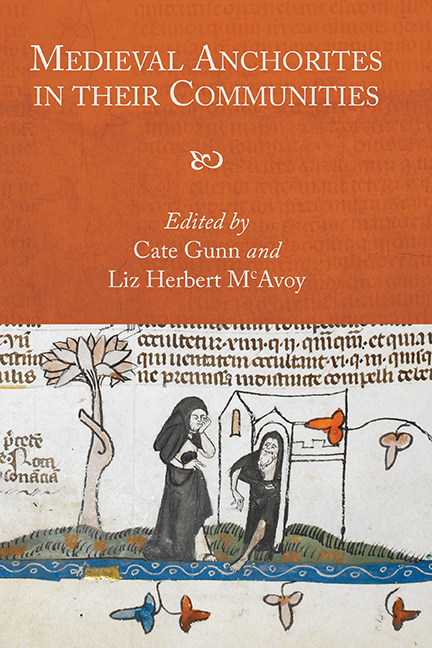Book contents
- Frontmatter
- Dedication
- Contents
- List of Illustrations
- Acknowledgements
- List of Contributors
- Abbreviations
- Introduction: ‘No Such Thing as Society?’ Solitude in Community
- 1 ‘O Sely Ankir!’
- Part I Religious Communities
- Part II Lay Communities
- 5 English Nuns as ‘Anchoritic Intercessors’ for Souls in Purgatory: The Employment of A Revelation of Purgatory by Late Medieval English Nunneries for Their Lay Communities
- 6 ‘In aniversaries of ower leoveste freond seggeth alle nihene’: Anchorites, Chantries and Purgatorial Patronage in Medieval England
- 7 ‘Item receyvyd of ye Anker’: The Relationships between a Parish and its Anchorites as Seen through the Churchwardens’ Accounts
- 8 The Curious Incident of the Hermit in Fisherton
- 9 Was Julian's Nightmare a Māre? Julian of Norwich and the Vernacular Community of Storytellers
- Part III Textual Communities
- Bibliography
- Index
- Miscellaneous Endmatter
7 - ‘Item receyvyd of ye Anker’: The Relationships between a Parish and its Anchorites as Seen through the Churchwardens’ Accounts
from Part II - Lay Communities
Published online by Cambridge University Press: 30 August 2017
- Frontmatter
- Dedication
- Contents
- List of Illustrations
- Acknowledgements
- List of Contributors
- Abbreviations
- Introduction: ‘No Such Thing as Society?’ Solitude in Community
- 1 ‘O Sely Ankir!’
- Part I Religious Communities
- Part II Lay Communities
- 5 English Nuns as ‘Anchoritic Intercessors’ for Souls in Purgatory: The Employment of A Revelation of Purgatory by Late Medieval English Nunneries for Their Lay Communities
- 6 ‘In aniversaries of ower leoveste freond seggeth alle nihene’: Anchorites, Chantries and Purgatorial Patronage in Medieval England
- 7 ‘Item receyvyd of ye Anker’: The Relationships between a Parish and its Anchorites as Seen through the Churchwardens’ Accounts
- 8 The Curious Incident of the Hermit in Fisherton
- 9 Was Julian's Nightmare a Māre? Julian of Norwich and the Vernacular Community of Storytellers
- Part III Textual Communities
- Bibliography
- Index
- Miscellaneous Endmatter
Summary
AMONGST the different types of community considered in this volume with regard to relationships with anchorites, an important one is that which was often physically closest to those who chose the enclosed life, that of the people who lived and worked in close proximity to the place where solitaries were enclosed. Since between the twelfth and the sixteenth centuries this was usually a church, and more often than not a parish church, the connections that could be made and maintained between a parish community and its anchorite are important ones, although ones which appear to have attracted comparatively little attention in studies either of anchorites or of parish life. This is not entirely surprising, of course, given that if little is known about most of the anchorites recorded in Britain in the Middle Ages, even less is known first-hand about how they interacted with those amongst whom they lived while enclosed. Yet where a record of such interaction survives, for example in the churchwardens’ accounts of a parish which hosted an anchorite or series of anchorites, insights may be gained into how both sides of this relationship benefitted. As will be seen, the opportunity for analysis of this type is rare, but can provide valuable material which is as yet mostly unexplored.
This lack of exploration of the links between anchorites and the surrounding and supporting parish is unusual, since there has been much work in recent decades on English religion and spirituality in the pre-Reformation period that has looked in greater or lesser detail at community interaction, and at the relationships within and between different sections of society. Analysing churchwardens’ accounts, records of feasts and festivals, wills and other such evidence helps to show that the parish was a significant element in the structure both of the church and of wider society, with an important focus on social interaction and corporate responsibility. There has also been a recognition in such analyses of the need for joint (although not necessarily equal) participation between clergy and laity in the work of the parish to sustain and build the community.
- Type
- Chapter
- Information
- Medieval Anchorites in their Communities , pp. 117 - 130Publisher: Boydell & BrewerPrint publication year: 2017

